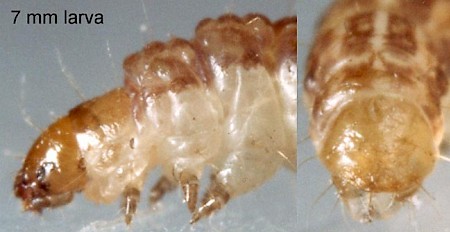
28.014 BF642
Crassa unitella
(Hübner, 1796)
Wingspan 12-16 mm.
This species is locally common in southern England, and occurs more scarcely as far north as Lancashrie and Yorkshire. It is rather less colourful than its close relatives lambdella and lunaris.
The adult flies from late June to August and sometimes comes to light It is associated with wooded areas because the larvae, late September to May, feed on fungus on and under dead bark.
- Larva: (description Ian F. Smith):
Food: Late September to May. Fungus on and under dead bark of trees.
Early instar (MBGBI references are to late instar).
Length: 7 mm described.
Head: Brown ochre (MBGBI; chestnut-brown). Darker brown postero-lateral mark. Frons and posterior edge of capsule thinly edged darker brown. Labium darker. Frons paler. Stemmata linked by black crescent shaped band.
Prothorax (T1): In profile, markedly lower than rest of body. Prothoracic shield transparent yellowish brown, showing head below. (MBGBI ; a little darker than head).
Thoracic legs: Greyish brown, except coxa concolorous with venter.
Body: Dorsally dull pinkish brown to dark brown. Yellowish intersegmentally and yellowish marks and irregular dorsal and dorsolateral lines. Ivory white below spiracles and ventrally.
Spiracles: Peritreme dark brown.
Abdominal pinacula: Concolorous with pale grey setal spot. (MBGBI; dark chestnut-brown).
Setae: Colourless translucent, faintly tinted pale brown basally.
Anal plate: Large. Translucent yellowish brown. (MBGBI; dark chestnut-brown).
Prolegs: Concolorous, except for a blackish band.

 UKMoths
UKMoths 





